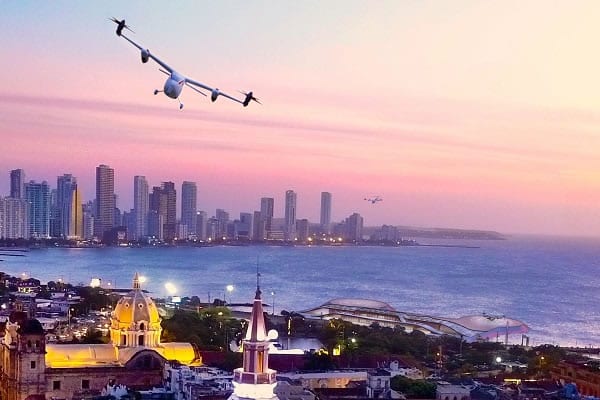
Varon Vehicles is looking at urban air mobility as an answer to mobility infrastructure problems. (Varon Vehicles)
Urban air mobility (UAM) is not air taxis, Felipe Varon, CEO and founder of Varon Vehicles, said during a Jan. 28 panel at the Vertical Flight Society’s 2021 Autonomous VTOL Technical Meeting and Electric VTOL Symposium. Varon argues that the focus of the UAM industry should be less about electric vertical take-off and landing (eVTOL) technology and more about mobility infrastructure.
“We feel that urban mobility, in its entirety, is a new type of mobility infrastructure,” Varon said.
The most important question people should ask themselves in the urban air mobility space is what problem they are trying to solve, Varon said. Some people have focused on eliminating traffic or pollution as the central problem that urban air mobility can fix. Varon said this is not the real problem they need to solve.
“It’s not an easy question to answer because we who come from the aviation industry box and unmanned systems, we try to answer that question from within that box, and I believe that’s a mistake,” Varon said. “I think that when we convey the message about urban mobility. We are conveying the message that it is the traffic problem that we’re trying to solve, and I believe that’s wrong. I believe that we are trying to solve something bigger. Where the traffic problem is a symptom of that. Where the pollution problem is a symptom of that. It’s the lack of proper mobility infrastructure, that is the problem that we’re trying to solve.”
Varon is trying to solve to apply urban air mobility to this problem in Latin America where mobility issues are especially acute.
The infrastructure that Varon is working on would have similarities to how a metro system functions, however, it would instead involve eVTOLs and ports. These ports would all be connected to each other by virtual lanes in low altitude airspace over cities and suburbs, Varon said.
“This resembles a lot what a metro system would be like,” Varon said. “Instead of having metro stations, we have 30 ports, and instead of having trains, but we have our eVTOL air vehicle fleets. Instead of having railroads we have virtual lanes. And that’s, again, what we call our infrastructure networks. That is what we are saying, are a new type of mobility infrastructure.”
There will be two big drivers of urban mobility in Varon’s view: automation and mobility as a service. Seeing mobility as a service will cater to changing views of transportation in society.

On Jan. 29, Jaunt Air Mobility and Varon Vehicles jointly announced a new collaboration to develop eVTOL infrastructure enabling technologies. Over the course of 2021, Jaunt will work with Varon to understand the unique transportation needs in Latin American cities to help define the operations and integration of the “Journey” aircraft the company is developing into service. (Jaunt Air Mobility)
“Those of you who are in their 40s, like myself, and were born in the 70s and 80s, you remember the value that we had in obtaining your driver’s license and of having your first car,” Varon said. “Well, that has changed. We don’t see that anymore in society and in young people because values have shifted. Now people see mobility as a service. That’s why we have transportation network companies being so successful.”
Automation will be a driver in building urban air mobility to a large scale and enabling it to compete with other transportation networks.
Urban air mobility will be a disruptor to existing infrastructure. It will offer competition to road systems and transportation, however, the advantage of urban air mobility infrastructure is that there is no cost per mile like currently available systems.
“It’s in the fact that our type of mobility infrastructure, does not require a cost per mile,” Varon said. “When you build a road system we build train or track systems, all those have a very expensive per mile construction because it’s physical. Well, our portion of that is virtual, and that’s the key for our industry to be successful. That’s where the disruption potential actually locked so that that changes many things when you take this perspective this city perspective.”